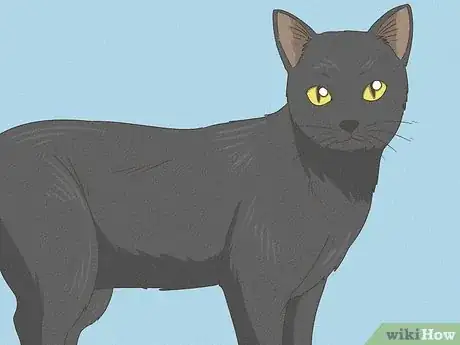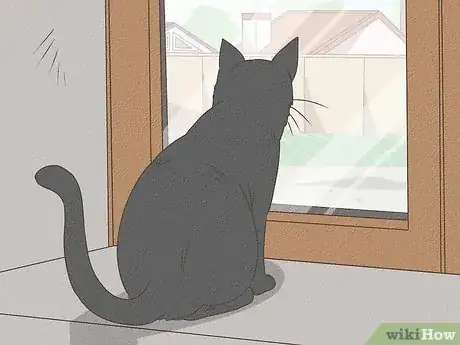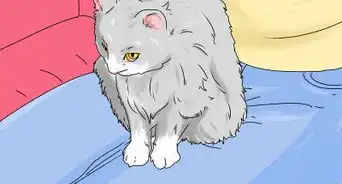This article was co-authored by Lauren Baker, DVM, PhD and by wikiHow staff writer, Jennifer Mueller, JD. Dr. Lauren Baker is a Veterinarian and Assistant Scientist at the University of Wisconsin-Madison. With over 10 years in veterinary medicine, she specializes in the concept of “one health,” which uses insights from veterinary medicine to help human medical research. She holds a Ph.D. in Comparative Biomedical Sciences, a Doctor of Veterinary Medicine, an MS in Comparative Biomedical Sciences, and a Bachelor’s degree in Psychology from the University of Wisconsin-Madison.
wikiHow marks an article as reader-approved once it receives enough positive feedback. In this case, 100% of readers who voted found the article helpful, earning it our reader-approved status.
This article has been viewed 305,273 times.
If you've always thought it would be fun to have a miniature panther, you might want to get a Bombay cat! These energetic black cats with rounded features and brilliant gold eyes were bred to look just like a smaller version of their wild jungle cousins. Inspired by India's majestic black leopards, the Bombay is a wonderful, playful pet that requires no more upkeep than any other domestic cat. Read on to learn everything you need to know about how to identify this distinctive and rare breed—including how to tell them apart from any other black cat.[1]
Things You Should Know
- Identify a Bombay cat on sight by their shiny black fur, gold or copper eyes, and rounded features.
- When a Bombay cat is on the move, it looks like a miniature black leopard, from its gait to its rippling muscles.
- Play with a Bombay cat often—they are curious, smart, and social cats that thrive on attention and stimulation.
Steps
Physical Characteristics
-
1Shiny, black fur
This breed is a mix between a black American Shorthair ("Domestic Shorthair" in the UK) and a sable Burmese. The result is a glossy, short coat with fur that's black all the way to the roots—just like the Indian black leopards they were bred to resemble.[2]- Known as the blackest of all black cats, Bombay kitties even have black paw pads (toe beans) and black noses.[3]
-
2Gold or copper eyes
A Bombay's eyes are usually larger and rounder than the average cat's, and they're always a gold or copper color. It's this feature combined with their black fur that gives them the nickname "the patent-leather kid with the new penny eyes."[4]Advertisement -
3Rounded features
Like the panther they're bred to resemble, Bombays have rounded ears and a rounded face with a short, rounded muzzle. Their feet are also rounder than most cats—even the tip of their tail is rounded, not pointy.[5]- Some people claim Bombays have special fangs or different teeth than other cats, but this isn't true. Bombays have the same teeth as other cats, and there's nothing about their teeth listed in the breed standard.[6]
-
4Muscular build
While Bombays are medium-sized cats, they're all muscle—this means they're typically heavier than you think they'll be when you pick one up. Adult males range from 8 to 10 pounds (3.6 to 4.5 kg), while females reach 6 to 8 pounds (2.7 to 3.6 kg).[7]- If you're comparing a Bombay cat to a regular black cat, the black cat will typically look leaner and longer than the Bombay.
-
5Swaying walk
These rare breed cats don't just look like panthers—they walk like them too! A regular black cat is going to walk like any other cat, but a Bombay takes on the gait of their wild cousins, walking with a swish and a sway on their rounded paws so they always look like they're on the prowl.[8]
Behavior and Personality
-
1Vocal
If you like to have conversations with your cat, you'd love a Bombay because they always have something to say. They love attention and will happily meow all day to anyone who responds. While they're not as loud as Siamese cats, they're more social—meaning they talk just as much, if not more.[9] -
2Smart and inquisitive
Bombay cats enjoy puzzle toys and games that test their smarts. They love to play fetch and learn new tricks. Don't be surprised if you have to add child locks to your kitchen cabinets to keep your Bombay from helping themselves to a treat![10]- A Bombay always wants to be where the action is so they can see what's going on. This is why your Bombay will often follow you around from room to room—they just want to know what you're doing.
-
3Active and playful
These muscular kitties need lots of exercise, especially when they're younger. A cat tree or other places to climb, jump, and run will give your Bombay plenty of exercise. You might also try getting them a harness so you can take them out for walks (yes, just like a dog).[11]- If you have kids, your Bombay will love playing with them and chasing them around the house. A lot of Bombay owners claim their cat acts more like a dog than a cat.
- If you have other pets, don't be surprised if your Bombay takes over and becomes the dominant pet of the household. If your pets get into mischief, it's likely the Bombay was the ringleader.
-
4Easy-going and sociable
Bombays are great with kids and other pets (even dogs) and love their people. Unlike many cats, your Bombay is likely to greet you at the door with a warm "meow" when you come home.[12]- Bombays tend to be lap cats, too. They want to be all over you, wherever you are, all the time.
- Their sociableness comes at a price: these extroverted felines do not like to be left alone for extended periods of time. If you don't have any other animals and know you'll have to leave them alone most of the day, this might not be the breed for you.
Care and Grooming
-
1Keep your Bombay cat indoors. Cats generally live longer, healthier lives if they're kept indoors, and Bombays are no exception. But this breed in particular is so curious, they're potentially more likely to get in trouble than some other cats if they're allowed to explore outdoors on their own.[13]
- It's also worth noting that, given the rarity of this breed, you likely spent a pretty penny for your precious Bombay. Letting them run around outside provides ample opportunity for your valuable pet to get lost or stolen.
- If you want to take your Bombay outside, try leash-training! Then you can take them out exploring without worrying they'll get into trouble.[14]
-
2Give your house panther plenty of places to scratch. Scratching is a natural behavior for cats, and Bombays are no exception. Make sure your parlor panther has a scratching post or two so they don't turn your couch into a scratching post instead.[15]
- As with all cats, you still want to trim your Bombay's nails every other week.
-
3Brush your cat once a week or so. A Bombay's short coat doesn't require any extensive grooming—a weekly brushing will keep it looking its best. Sometimes, all you need to do is run a lint-free cloth over it to clean off dust and loose hairs and give it a subtle sheen.[16]
- As with any cat, it's also a good idea to brush your Bombay's teeth once a week to help prevent gum disease.[17]
-
4Pet and love on your Bombay frequently. Cats have the reputation for being standoffish, but that stereotype definitely does not apply to Bombays. These cuddly kitties crave affection and will crawl and climb all over you to get you to pay attention to them.[18]
-
5Feed Bombays wet food with mostly animal protein twice a day. These sturdy, muscular cats need a lot of protein to keep their bodies in top shape and give them the energy they need. In addition to wet food, keep dry food available at all times.[19]
- Bombays are very eager eaters that can be prone to overeating. Puzzle feeders will help them eat more slowly.
- Make sure your Bombay gets plenty of exercise so they're not at risk for obesity.
-
6Take your Bombay to the vet for a checkup at least once a year. Many purebred pets are at greater risk for various genetic diseases and disorders. This isn't true for Bombays, being a relatively recent breed and still very rare. At the same time, though, you want to make sure your precious parlor panther is as healthy as they can be with yearly checkups.[20]
- As with all cats, Bombays are at risk for hypertrophic cardiomyopathy. This is the most common heart disease among cats and can result in heart failure. Although it's genetic, it won't show up for the first few years of your cat's life, so screening your adult cat is crucial.
- Knowledgeable breeders test their breeding cats for other genetic diseases. If you're looking to add a Bombay cat to your home, only adopt from a respected breeder with a good reputation.
-
7Expect your Bombay to live 15-17 years. These healthy, hardy cats tend to live pretty long lives, which means you have many years of Bombay cuddles and hijinks to look forward to. When they get older, they do tend to slow down a little (like most cats do), but they'll never stop seeking attention and affection from you.[21]
References
- ↑ https://cfa.org/bombay/
- ↑ https://cfa.org/wp-content/uploads/2019/06/bombay-standard.pdf
- ↑ https://vcahospitals.com/know-your-pet/cat-breeds/bombay
- ↑ https://www.tica.org/breeds/browse-all-breeds?view=article&id=2079
- ↑ https://cfa.org/bombay/
- ↑ https://cfa.org/wp-content/uploads/2019/06/bombay-standard.pdf
- ↑ https://www.tica.org/breeds/browse-all-breeds?view=article&id=2079
- ↑ https://www.tica.org/breeds/browse-all-breeds?view=article&id=2079
- ↑ https://vcahospitals.com/know-your-pet/cat-breeds/bombay
- ↑ https://www.tica.org/breeds/browse-all-breeds?view=article&id=827:bombay-breed&catid=79
- ↑ https://vcahospitals.com/know-your-pet/cat-breeds/bombay
- ↑ https://www.tica.org/breeds/browse-all-breeds?view=article&id=827:bombay-breed&catid=79
- ↑ https://cfa.org/bombay/
- ↑ https://vcahospitals.com/know-your-pet/cat-breeds/bombay
- ↑ https://cfa.org/bombay/
- ↑ https://www.tica.org/breeds/browse-all-breeds?view=article&id=2079
- ↑ https://cfa.org/bombay/
- ↑ https://www.tica.org/breeds/browse-all-breeds?view=article&id=827:bombay-breed&catid=79
- ↑ https://www.tica.org/breeds/browse-all-breeds?view=article&id=2079
- ↑ https://www.tica.org/breeds/browse-all-breeds?view=article&id=2079
- ↑ https://www.tica.org/breeds/browse-all-breeds?view=article&id=2079
About This Article
To identify a Bombay cat, start by looking for defining characteristics, such as shiny black fur, gold or copper eyes, and a rounded head and shoulders with a short nose. Additionally, check to see if your cat has a strong, muscular build, which is common in Bombay cats. You can also tell if you have a Bombay cat by watching to see if it has a swishing, swaying, panther-like walk. A Bombay cat will also be very talkative, so in addition to watching your cat, listen to it as well. For more tips from our Veterinary reviewer, including how to identify a Bombay cat by its intelligence, keep reading!
















































































